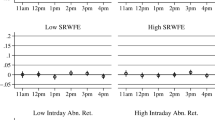Abstract
Over the past 30 years managers have increasingly focused on improving inventory management both within their own firms and across the supply chain. To this end, inventory turns metrics have been adopted as a popular tool for measuring flow velocity through the inventory and the efficiency of inventory-related asset utilization. There are multiple computational methods thereof currently used by practitioners, but each has some flaws. In particular, consensus is lacking as to (1) how to measure inventory flow and (2) how to measure the inventory level. Clearly, high-quality accounting information is essential for an accurate assessment of all inventory performance metrics. Unfortunately, when comparing efficiencies across firms or diagnosing and correcting intra-firm inefficiencies, choices of specific accounting rules and distortions between fair market values and corresponding accounting book values can lead to potentially misleading results. This paper presents finite-horizon versions of Little’s Law and elucidates their connection to inventory turns and restricted sojourn times in inventory, defined as the portion of the full sojourn time that falls within a prescribed time period. In particular, it explains when the reciprocal of sample inventory turns coincides with the sample average of restricted sojourn times. As such, the paper provides a unified prescriptive model for correctly relating inventory turns to sojourn times through an inventory system, thereby facilitating more accurate intra-firm and cross-firm comparisons.





Similar content being viewed by others
References
Alan, Y., Gao, G. P., & Gaur, V. (2014). Does inventory productivity predict future stock returns? A retailing industry perspective. Management Science, 60(10), 2416–2434.
Balakrishnan, R., Linsmeier, T. J., & Venkatachalam, M. (1996). Financial benefits from JIT adoption: Effects of consumer concentration and cost structure. Accounting Review, 71, 183–205.
Ballou, R. H. (1981). Estimating and auditing aggregate inventory levels at multiple stocking points. Journal of Operations Management, 1(3), 143–153.
Ballou, R. H. (2000). Evaluating inventory management performance using a turnover curve. International Journal of Physical Distribution & Logistics Management, 30(1), 72–85.
Ballou, R. H. (2005). Expressing inventory control policy in the turnover curve. Journal of Business Logistics, 26(2), 143–164.
Blinder, A. S., & Maccini, L. J. (1991). Taking stock: A critical assessment of recent research on inventories. Journal of Economic Perspectives, 5(1), 73–96.
Billesbach, T. J., & Hayen, R. (1994). Long-term impact of JIT on inventory performance measures. Production Inventory Management Journal, 35(1), 62–67.
Chang, D., & Lee, S. M. (1995). Impact of JIT on organizational performance of U.S. firms. International Journal of Production Research, 33, 3053–3068.
Chikán, A. (2009). An empirical analysis of managerial approaches to the role of inventories. International Journal of Production Economics, 118(1), 131–135.
Chikán, A. (2011). Managers’ view of a new inventory paradigm. International Journal of Production Economics, 133(1), 54–59.
Demeter, K., & Matyusz, Z. (2011). The impact of lean practices on inventory turnover. International Journal of Production Economics, 133(1), 154–163.
Eroglu, C., & Hofer, C. (2011). Lean, leaner, too lean? The inventory-performance link revisited. Journal of Operations Management, 29(4), 356–369.
Gaur, V., Fisher, M. L., & Raman, A. (2005). Econometric analysis of inventory turnover performance in retail services. Management Science, 51(2), 181–194.
Hendricks, K. B., & Singhal, V. R. (1997). Does implementing an effective TQM program actually improve operating performance: Empirical evidence from firms that have won quality awards. Management Science, 43, 1258–1274.
Huson, M., & Nanda, D. (1995). The impact of just-in-time manufacturing on firm performance. Journal of Operations Management, 12, 297–310.
Katehakis, M. N., & Smit, L. C. (2012). On computing optimal \((Q{,}r)\) replenishment policies under quantity discounts. Annals of Operations Research, 200(1), 279–298.
Kolias, G. D., Dimelis, S. P., & Filios, V. P. (2011). An empirical analysis of inventory turnover behaviour in Greek retail sector: 2000–2005. International Journal of Production Economics, 133, 143–153.
Konstantopoulos, T., Zazanis, M., & De Vecian, G. (1996). Conservation laws and reflection mappings with an application to multiclass mean value analysis for stochastic fluid queues. Stochastic Processes and their Applications, 65(1), 139–146.
Little, J. D. C., & Graves, S. C. (2008). Little’s Law. In D. Chhajed & T. J. Lowe (Eds.), Building intuition: Insights from basic operations management models and principles. Berlin: Springer Science.
Mishra, S., Modi, S. B., & Animesh, A. (2013). The relationship between information technology capability, inventory efficiency, and shareholder wealth: A firm-level empirical analysis. Journal of Operations Management, 31(6), 298–312.
Rajagopalan, S., & Malhotra, A. (2001). Have U.S. manufacturing inventories really decreased? An empirical study. Manufacturing Service Operations Management, 3, 14–24.
Schonberger, R. J. (2003). The right stuff, revisited. MSI, 21(9), 26–30.
Shi, J., Katehakis, M. N., & Melamed, B. (2013). Martingale methods for pricing inventory penalties under continuous replenishment and compound renewal demands. Annals of Operations Research, 208(1), 593–612.
Shi, J., Katehakis, M. N., Melamed, B., & Xia, Y. (2014). Production-inventory systems with lost sales and compound Poisson demands. Operations Research, 62(5), 1048–1063.
Simchi-Levi, D., Kaminsky, P., & Simchi-Levi, E. (2008). Designing and managing the supply chain (3rd ed.). New York: McGraw-Hill.
Weygandt, J. J., Kimmel, P. D., & Kieso, D. E. (2012). Financial accounting (8th ed.). New York: Wiley.
Wiendahl, H. P., & Breithaupt, J. W. (2000). Automatic production control applying control theory. International Journal of Production Economics, 63(1), 33–46.
Zeng, A. Z., & Hayya, J. C. (1999). The performance of two popular service measures on management effectiveness in inventory control. International Journal of Production Economics, 58(2), 147–159.
Author information
Authors and Affiliations
Corresponding author
Rights and permissions
About this article
Cite this article
Melamed, B., Leuschner, R., Chen, W. et al. Inventory turns and finite-horizon Little’s Laws. Ann Oper Res 317, 129–146 (2022). https://doi.org/10.1007/s10479-016-2157-9
Published:
Issue Date:
DOI: https://doi.org/10.1007/s10479-016-2157-9




